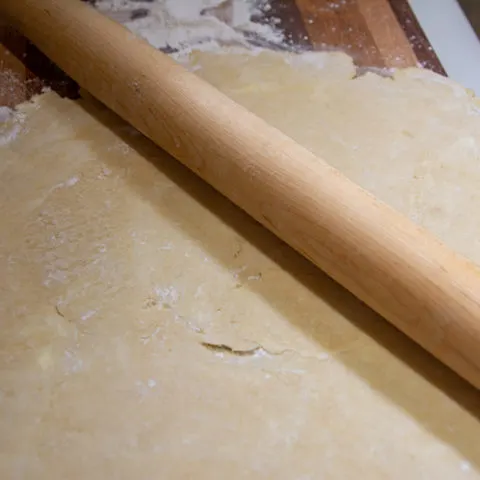In Salt, Fat, Acid, Heat: Mastering the Elements of Good Cooking by Samin Nosrat, she introduces Aaron’s Tart Dough, from her friend Aaron Hyman. In this recipe, he swaps out some of the butter for Crème Fraiche or plain cream. The recipe produces a dough easily big enough for an 11″ (~28cm) tart that is easier to make and I think improves the taste. The result is touted as an all-purpose tart dough that may be made and frozen and ready for whatever is available from the market whether sweet or savory is desired. This flexible idea is intriguing. For reference here is a modified form of this dough (I have reduced the sugar) that I think is an improvement.
Notes in Enhancement
Regardless of whatever your recipe is for savory tarts, this dough is likely an improvement.
Aaron’s dough is great, but through a detailed analysis, I think I have built on the concepts and developed an improved tart dough. In my improved dough, I reduce the Crème Fraiche a bit and add back an egg. This produces a flakier and richer dough. I have included recipes for 9″ and 11“ doughs.
Notes on Technique
The combination of ingredients and the technique makes this the easiest tart dough you might ever make. The Crème Fraiche addition is easier to work with than pure butter. And does improve the taste.
Freezing Equipment and Forming Disc
The technique involves freezing your equipment before starting. This greatly helps. Lastly, I have recommended forming the dough into a disc before refrigerating. This also helps to make it easier to work with.
Regardless of whether you use Aaron’s Tart dough or my improved tart dough, you will be happy with the improvements in taste and technique. Additionally, here are some tips to make the process much easier.


Hand Finishing
Escoffier offers this perfect description of the last step of finishing the dough. Use the palm of your hand to press the butter through the dough. Not much is needed, but it helps you get a perfect feel of the dough and whether it is blended correctly.
“When the paste is mixed, roll it into a mass; put it on the board; then press it away from you, little by little, between the board and the palm of the hand. For the paste to be perfectly smooth, it ought to be treated twice this way.”
Auguste Escoffier, Guide Culinaire, 1903
Related Posts

Aaron's Tart Dough
Made famous by Samin Nosrat, this tart dough uses cream in the place of butter. Working with this dough is easier.
Ingredients
- 240g (1⅔ cups) all purpose flour
- 28g (2 tablespoons) sugar, (see note 1)
- ¼ teaspoon baking powder
- 1 teaspoon salt
- 115g (8 tablespoons) butter, cut into ½ inch cubes
- 85g (6 tablespoons) crème fraiche (or cream)
- 2 to 3 tablespoons cold water
Instructions
To make the dough
- If using a mixer, chill the bowl, and paddle in the freezer for at least 20 minutes.
- Whisk the flour, sugar, and salt together. Assemble the mixer and bowl, and add dry ingredients.
- With the mixer on low, slowly add the cubes of butter. Mix for two or three minutes. The butter should be well cut into the dough. After all the pieces of butter or added, increase the speed slightly. Slivers of butter should remain visible. If some bigger chunks remain, work the bigger pieces of butter into the flour between your fingers.
- Mix the creme fraiche into the dough on low. The dough should start binding together. Add water if needed to improve texture.
- Place the dough on a work surface, roll it into a mass; put it on the board; then press it away from you, little by little, between the board and the palm of the hand. This final step makes sure the butter is fully incorporated and the dough sticks together.
- Lay a large piece of plastic wrap out and dump the dough onto the wrap. Gather the dough together by lifting the edges of the wrap. This can help you press the dough together. Shape the dough into a 1 ½ to 2-inch disc. (The disc shape gives you a head start into rolling out to a flat tart crust.)
- Cover with wrap and refrigerate for at least three hours.
To partially bake shell
- Center a rack in the oven and preheat to 400°F.
- Roll out the dough on a floured surface or between two pieces of wax paper. The disc shape should start you on the way. Work quickly to keep dough cold while rolling not stretching. If working on a floured surface turn the dough with a quarter turn frequently to keep from sticking. With the paper lift and adjust to keep from sticking.
- Place the dough inside the tart pan. Carefully push into corners without stretching. Prick the surface of the dough slightly with a fork to prevent air bubbles. Only 4 or 5 pricks should be needed. Coat the dough with foil or parchment paper. Fill with dried beans or pie weights.
- Bake for about 20 minutes until crust edges are lightly browned. (This assumes there will be approximately 30 minutes more baking after the tart is filled. Adjust as needed.)
Notes
Note 1: Sugar is half of the original recipe. Consider increasing if you are using very bitter greens.
Makes an 11" (28cm) dough.
Adapted from Samin Nosrat's Salts Fats Acid and Heat
Nutrition Information:
Yield: 4 Serving Size: 1 gramsAmount Per Serving: Calories: 537Total Fat: 33gSaturated Fat: 21gTrans Fat: 1gUnsaturated Fat: 10gCholesterol: 89mgSodium: 542mgCarbohydrates: 53gFiber: 2gSugar: 8gProtein: 7g
Calculated Nutrition is estimated.





Gal
Saturday 1st of May 2021
Hello Jeff,
In the recipe above you indicate 23 tablespoons sugar... I think you mean 2 tablespoons?
Jeff Zeanah
Saturday 1st of May 2021
Yes! Thank you for noticing. Sorry about the fat fingers, it is 2 tablespoons.